The ForestEyes’ Project needs your help to track tropical forests’ deforestation. You can contribute analyzing and classifying remote sensing image tiles in Forest or Non-forest. Those remote sensing images are from LANDSAT-8’s bands, freely available at Earth Explorer. The pixels have 30m resolution which means that each pixel corresponds to an area of 900 square meters. Access https://www.zooniverse.org/projects/dallaqua/foresteyes/classify and contribute to the project!
No encerramento da Conference on Patterns, Graphics and Images (SIBGRAPI 2023), em Rio Grande – RS, o aluno da Unifesp Eduardo Bouhid Neto foi agraciado com o prêmio de melhor trabalho de graduação. O artigo é fruto da Iniciação Científica do aluno e contou com a coautoria de Paulo Roberto Costa Pedro e do Prof. Dr. Álvaro Luiz Fazenda, além da orientação do Prof. Dr. Fabio Augusto Faria.
O trabalho propôs um arcabouço de seleção de bandas de imagens multiespectrais de sensoriamento remoto utilizando o algoritmo de estimação de distribuição estocástico (UMDA). A pesquisa teve como objetivo selecionar as bandas espectrais do satélite Landsat-8 que melhor representam áreas de desmatamento, desempenhando um papel crucial no monitoramento dessas regiões vitais para o ecossistema global.
Os resultados dos experimentos realizados foram excepcionais, com diversas composições identificadas pelo algoritmo UMDA alcançando uma acurácia balanceada superior a 90% na tarefa de classificação de segmentos de imagens. Em destaque, a composição de bandas 651 apresentou os melhores resultados tanto para classificação quanto para segmentação semântica, quando comparada a outras composições comumente utilizadas na arquitetura.
O trabalho foi desenvolvido dentro do projeto ForestEyes, que é apoiado pelo Interscity. As bases de dados utilizadas foram produzidas por membros do projeto e pretende-se aplicar os resultados obtidos ao fluxo de trabalho do projeto, de forma a melhorar o desempenho na detecção de desmatamento. O artigo está disponível em: https://arxiv.org/abs/2311.10513
On November 22, the United Nations Statistics Division, together with other statistics organizations around the world, organized the UN Big Data Hackathon. Its goal was to develop ideas and solutions to help achieve the Sustainable Development Goals and to assist in resolving Global challenges.
Scipopulis, one of the members of the InterSCity project, took part in the challenge and analyzed disaster data along with socio-economical features of the cities where those disasters occurred to identify possible city characteristics that potentialize the occurrence of extreme climate events. With this project, Scipopulis won the prize as Best Latin America team in the Big Data Experts category.

The article “Drones in the Big City: Reducing Collisions in Air Deliveries” (in Portuguese), whose authors were Fabíola de Oliveira (UFABC), Luiz Fernando Bittencourt (UNICAMP), Reinaldo Bianchi (FEI), Carlos Kamienski (UFABC), received an award for best paper at the VI Workshop on Urban Computing (CoUrb) of the XL Brazilian Symposium on Computer Networks and Distributed Systems (SBRC 2022), in the city of Fortaleza, Ceará.
The workshop’s idea is to implement intelligent solutions to these problems; Urban Computing emerges as a process of acquisition, integration, and analysis of a large amount of heterogeneous data generated from different sources in urban spaces (portable devices, sensors, vehicles, humans). In this context, Urban Computing is an interdisciplinary area that connects information and communication technology, advanced management of large volumes of data, and diverse methods of analysis of collected data. To better plan the future of cities and improve the quality of life of its inhabitants, Urban Computing aims to understand the nature of urban and social phenomena.
The workshop, which took place in May 2022, had about 20 presentations. The article “Drones in the Big City: Reducing Collisions in Air Deliveries” received the award for best paper and was invited to submit an extended version in the ITU Journal on Future and Evolving Technologies.

Click here to see the paper.
Robson Aleixo, Fabio Kon, Rudi Rocha, Marcela Camargo, and Raphael De Camargo, authors of the paper “Predicting Dengue Outbreaks with Explainable Machine Learning”, awarded the Best Paper in International Workshop on Artificial Intelligence for Health – AI4Health – wich occurs in May 2022.
The workshop happened in conjunction with the 22nd IEEE/ACM International Symposium on Cluster, Cloud and Internet Computing – CCGrid 2022 – and aimed at bringing together researchers from academia, industry, government, and medical centers to present state of the art and discuss the latest advances in the emerging area of the use of Artificial Intelligence and Soft Computing techniques, be they black boxes or explanation-based, to signals, images, and data in the fields of medicine, healthcare, and wellbeing.
The topics of interest included Knowledge Management of Health Data, Decision Support Systems for Healthcare and Wellbeing, Information and networking security in healthcare, and much more.
It was about 16 submissions and only 9 of them invited the authors of the papers to make a short presentation about the research realized, which the article mentioned won the Best Paper award.

Click here to see the paper.
Scipopulis, an innovation arm of InterSCity that works with data analysis, processing, integration, and visualization, focusing on turning cities into smart cities, won the Katowice Energy Innovation Challenge, whose results happened in June 2022.
The Challenge UN-Habitat organized was looking for digital information management and communication solutions to help and empower the city of Katowice, including the local government, residents, and businesses, to embrace a transition to clean and renewable energy systems.
It was called start-ups, cooperatives, social cooperatives, companies, and joint-stock companies with experience in implementing urban energy innovation projects.
The jury was impressed by the quality of pitches and the potential that these solutions have to help support the achievement of the 2030 Agenda and SDG 7, which calls for ensuring access to affordable, reliable, sustainable, and modern energy for all.
Maimunah Mohd Sharif, UN-Habitat Executive Director, said: “Cities are the incubators of innovation and new technologies. Therefore, we must support the development of solutions that provide resource-efficient energy locally to replace fossil fuels. The Katowice Energy Innovation Challenge winners are examples of how we should approach the transition to green and sustainable cities that care for the benefit of all.“
To see more details about the Katowice Energy Innovation Challenge, click here.
The three winners, including Scipopulis, were selected to participate in an accelerator program and present their work at the 11th Session of the World Urban Forum in Katowice, Poland, which occurs in the final of June 2022.

Furthermore, Scipopulis is a finalist in the Climate Smart Cities Challenge of Bogotá organized by UN-Habitat and Viable Cities. The Climate Smart Cities Challenge is an open innovation competition to identify innovative solutions to reduce the climate impact of Bogotá, Colombia; Bristol, United Kingdom; Curitiba, Brazil; and Makindye Ssabagabo, Uganda.
The challenge of Bogotá aims to innovative business models, services, and technologies that improve freight mobility and reduce congestion-based greenhouse gas emissions and air pollutants emissions from logistics operations in Bogotá, Colombia (by 100,000 tonnes of CO2 and 100 tonnes of PM2.5 by 2024, approximately).

After receiving nearly 200 applications from across 29 countries, 100 applications were shortlisted by expert assessors, and from this shortlist, 45 were selected by the city panels to be finalists. These 45 finalists will move to the next stage of the challenge and start their journey toward system demonstrations.
The finalists will now participate in the co-creation phase, where they will work closely with the cities, challenge partners, and each other. They will benefit from support and exciting opportunities to further their proposals and develop teams. Up to four teams will then be selected to move into the penultimate stage of the challenge and plan the system demonstrations, which occur until November 2022.
Click here to see more details of the Climate Smart Cities Challenge of Bogotá.
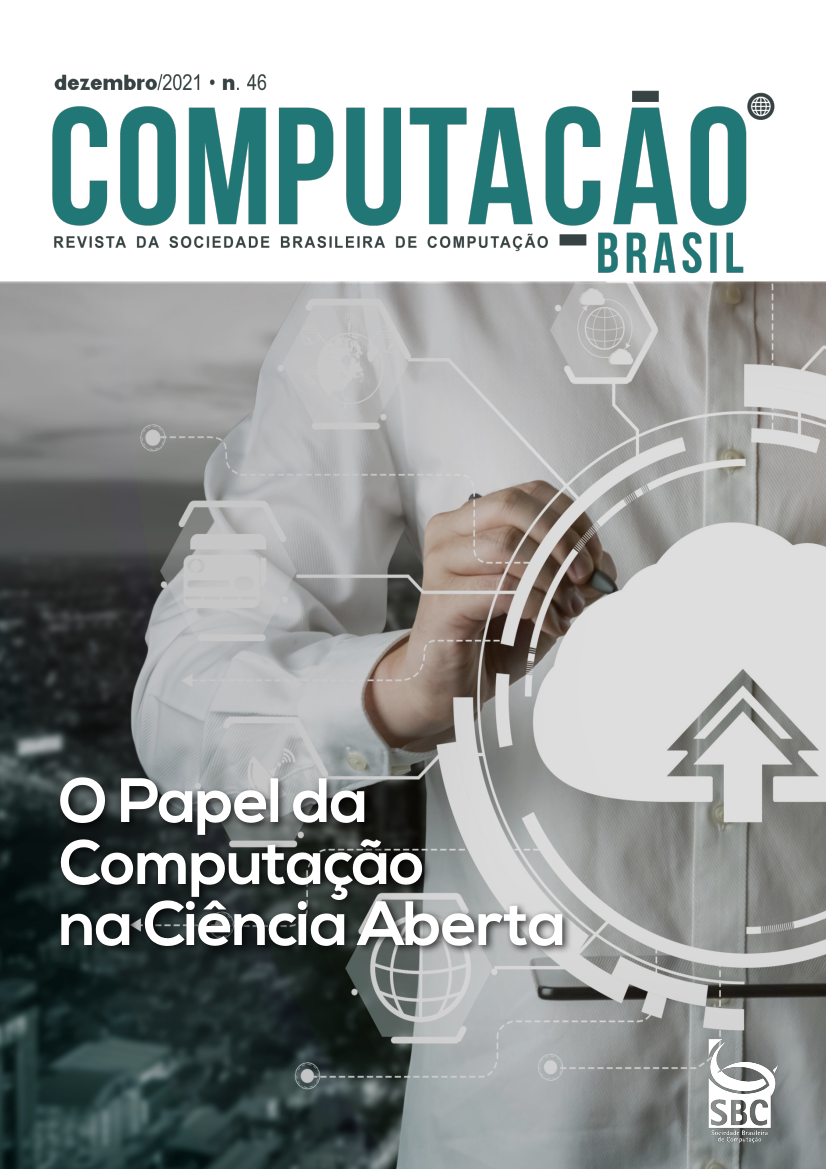
Photo reproduction of the issue front cover
In a special edition of Revista Computação Brasil, dedicated to Open Science and edited by Prof. Claudia Bauzer Medeiros, specialists from the country point out and contextualize issues that are intrinsic to the effective development of collaborative research in the country as well as in the world. Their aim was to show how Open Science can be possible, comprehensive, and sustainable. Members of INCT InterSCity made their contributions with 3 articles included in issue 46 of the journal, published in December 2021.
Christina von Flach (UFBA) and Fabio Kon (InterSCity), in the article “FREE SOFTWARE: PREREQUISITE FOR OPEN SCIENCE”, give us the scenario of the birth and growth of free software in Brazil, and how the strengthening of its culture is urgent and necessary for the appropriation of Open Science practices, in academia and beyond.
The article on page 20 “COMMON CITIZENS HELPING IN THE FIGHT AGAINST THE DEFORESTATION OF TROPICAL FORESTS” introduces the concept of Citizen Science and its importance in Open Science practices, and it gives us the example of the INCT InterSCity project “ForestEyes”, for volumetric monitoring of forests. Fernanda BJR Dallaqua (ICT/Unifesp), Álvaro L. Fazenda (InterSCity), and Fabio A. Faria (ICT/Unifesp) identified how Open Science can be fed back by the practices of Citizen Science, boosting the dissemination and appropriation of knowledge by non-expert members of society, while providing ammunition for research with significant volumes of data.
“COVID-19 DATA SHARING/BR: A SUSTAINABLE INFRASTRUCTURE FOR OPEN RESEARCH DATA” describes the endeavor, coordinated by FAPESP with infrastructure provided by USP, to make data files available securely and within specific parameters in the healthcare sector to hundreds of researchers in the race to understand the pandemic. Fátima LS Nunes (USP) and João Eduardo Ferreira (InterSCity) highlight that the standardization of data, the availability of tools (free SW), and WEB interfaces for data management were essential to guarantee, in a short time, the viability of research with geographically remote collaborators, within the precepts of Open Science.
To access issue 46 of Revista Computação Brasil and read the whole texts (PT-BR) |online |journal, pdf|
Text by Edina Arouca
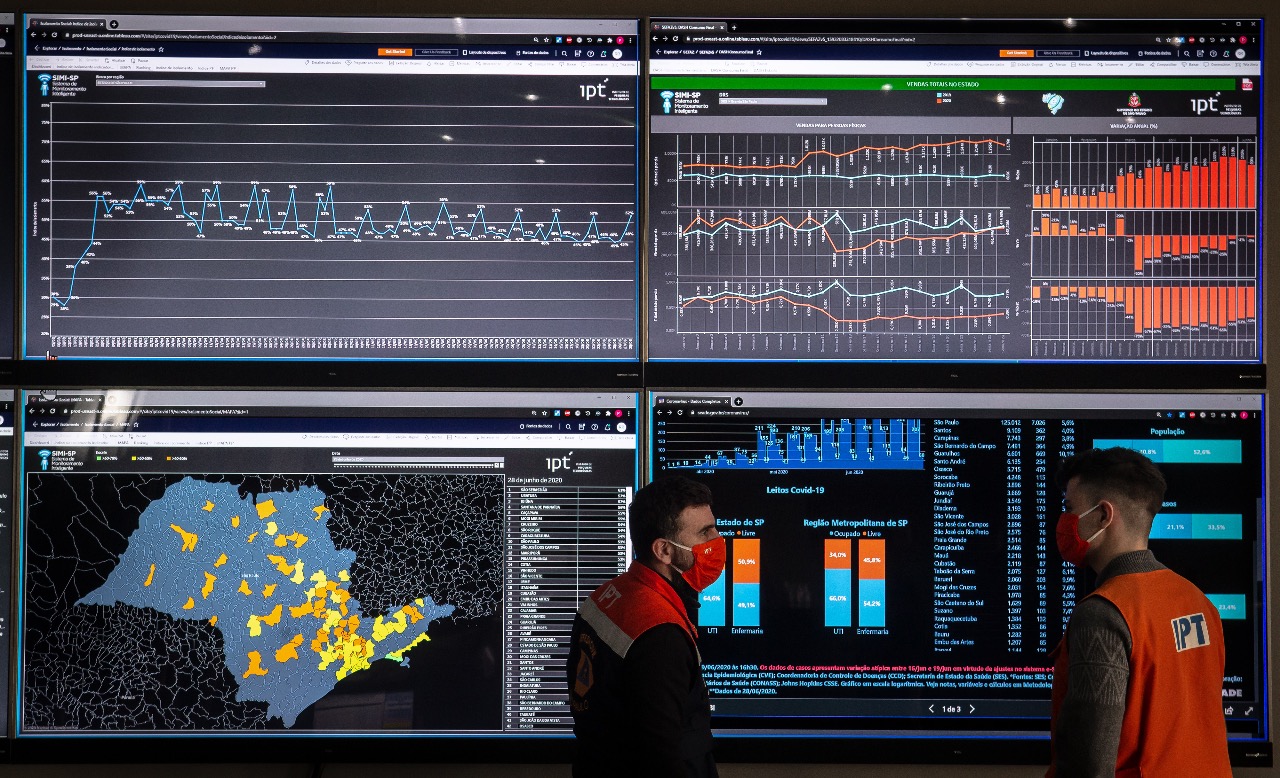
The Brazilian Symposium on Multimedia and Web (WebMedia) is an annual event held by the Brazilian Computer Society (SBC) and, since 1995, it has been one of the most important forums in Brazil for debates between researchers, professionals and students in the multimedia areas, hypermedia and web.
The “Luiz Fernando Computing Award” is promoted within WebMedia, which aims to honor professors, researchers and students involved in innovation projects that have a social impact and promote the improvement of society. This year, the solution ‘Covid-19 Intelligent Monitoring System in SP‘ was awarded with an honorable mention, presented by Institute for Technological Research (IPT), which applied digital technologies to integrate and support decision-making in facing the new coronavirus pandemic in the São Paulo state. This solution had the contribution of many partners, especially FAPESP’s PDIP–IPT projects (process no. 2017/50343-2) and InterScity, which were very important to face Covid-19 in São Paulo. In 2021, the event received a total of 18 submissions, focused on social impact, from institutions throughout Brazil and from different areas. The solutions were evaluated by a program committee and, at the end of the review process, the four best tools were presented in Symposium.
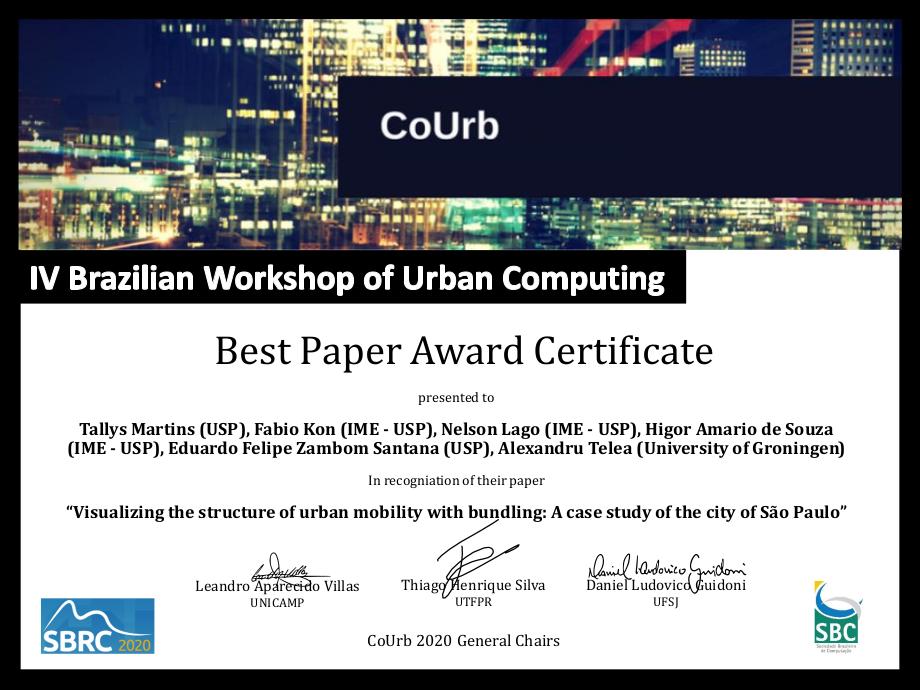
Best paper in CoUrb workshop for the paper “Visualizing the structure of urban mobility with bundling: A case study of the city of São Paulo“, by Tallys Martins (IME-USP), Fabio Kon (IME-USP), Nelson Lago (IME-USP), Higor Amario de Souza (IME-USP), Eduardo Felipe Zambom Santana (IME-USP), and Alexandru Telea (University of Groningen);
Best paper in the tools demo session to the paper “Using the InterSCSimulator to Evaluate Systems and Urban Scenarios“, by Eduardo Zambom Santana (IME-USP) and Fabio Kon (IME-USP);
Honorable mention in the WBlockchain Workshop to the paper “AutAvailChain: Disponibilização Segura, Controlada e Automática de Dados IoT usando Corrente de Blocos“, by Gustavo Camilo (GTA-UFRJ), Gabriel Rebello (GTA-UFRJ), Lucas Airam Souza (GTA-UFRJ), and Otto Carlos Muniz Bandeira Duarte (GTA-UFRJ);
Honorable mention in the Ph.D. thesis contest to the thesis “Collaborative and Infrastructure-less Vehicular Traffic Rerouting for Intelligent Transportation Systems”, by Ademar Takeo Akabane under the supervision of Leandro Aparecido Villas and co-supervision of Edmundo Roberto Mauro Madeira;
Such awards are an honor to the members of the project and provide a strong incentive for students, researchers, and professors to continue developing good scientific research. All mentioned papers can be found in the whole on Publications page.
During the second half of 2020, a team made up of undergraduate and graduate students who were studying the Advanced Data Science Laboratory discipline were able to focus their efforts on solving some challenges of Querido Diário, a project of the Data Science for Civic Innovation Program at OKBR that seeks to release data from the official journals of Brazilian municipalities. The partnership signed between Open Knowledge Brasil and the Institute of Mathematics and Statistics of the University of São Paulo (IME-USP) ended in December 2020 with many advances for Querido Diário.
The team had as a database a set of PDF documents collected between February 1st and June 15th using scrapers already developed for 391 municipalities. The project’s objective was to analyze the content of the texts to identify possible suspicious purchases related to measures to combat the coronavirus pandemic. Thus, the set contained documents that cited at least one of eleven relevant terms, such as “bidding waiver”, “Personal Protective Equipment”, and “lung ventilators”.
Many challenges in the universe of data analysis were faced, such as the unfavorable layout of most official journals. The texts, usually arranged in two columns, make it difficult for an automated interpretation by a code, which interprets only one line at a time in its development pattern. Characteristics related to the lack of standardization of the diaries are a problem that crosses this and several other fronts of Querido Diário, such as the Census of Official Diaries – a survey of the online availability of publications in each municipality.
The proposed solution to search for suspicious purchases was to survey the CNPJs of companies that appear in the official journals as providers of some service to city halls and the subsequent cross-referencing with external bases, such as the Registry of Disreputable and Suspicious Companies and that of campaign donations elections realized in 2016.
As a result, the group extracted 23,070 CNPJs, of which 1% were invalid. The most likely cause is typos that end up being recorded in an official document, revealing a failure in the transparency of the information. From the crossing with the two bases, no record was found that could be considered suspicious.
All the code generated by the team, composed by Gabriel Trettel, George Othon, Tiago Lubiana, and Wesley Seidel, is available for free access in this repository.
Credits: text written by Ariane Alves and adapted.
On 06/12, we had the first InterSCity project webinar, open to the general public. With the participation of 158 people among the 389 registered, the two presentations on the first day of the webinar was well received by the participants, who submitted several questions over chat.
The first presentation described the use of the InterSCity platform by the Institute for Technological Research (IPT) in monitoring various data, including those related to covid-19. The second showcased a Scipopulis tool for the analysis of emissions generated by public transport in São Paulo, aimed at assisting in meeting the emission reduction targets of the new public transport bid in the city. The slides and videos of the presentations (in Portuguese) can be found on the InterSCity webinar series page.
The next InterSCity project webinars will take place on 6/26 and 10/7; find out more and see how to register.
The third edition of the InterSCity (National Science and Technology Institute – INCT – of the Future Internet for Smart Cities) Workshop is being held from April 7th to June 9th. The event was planned to take place from April 5th to 8th in Itamambuca (SP), but was restructured to take place remotely, via Internet, due to the coronavirus pandemic. The presentations were rescheduled and divided in 5 technical sessions covering the topics of urban mobility, computer networks, Internet of Things platforms, Big Data, cloud computing, middleware, and citizen science. The aim of the workshop is to allow InterSCity members to present and discuss ongoing research and the possibilities of future projects.
The first session, held on April 7th, was about urban mobility. It gathered 48 participants (professors, researchers, experienced industry experts, and graduate and undergraduate students) from 7 institutions via video conference.
The session started with the work “Visualization of Source-Destination data with Bundling” presented by the Masters student Tallys Gustavo Martins, supervised by Professor Fabio Kon from IME-USP. Tallys showed the results obtained with the application of different visualization techniques that can be used to facilitate the detection of mobility patterns in a city. The main source of data for this work was the Origin-Destination Survey conducted by Companhia do Metropolitano de São Paulo. The pattern matching between the flows identified by Tallys’ work and the main mobility infrastructure of the city proves that the project reached its main objectives.
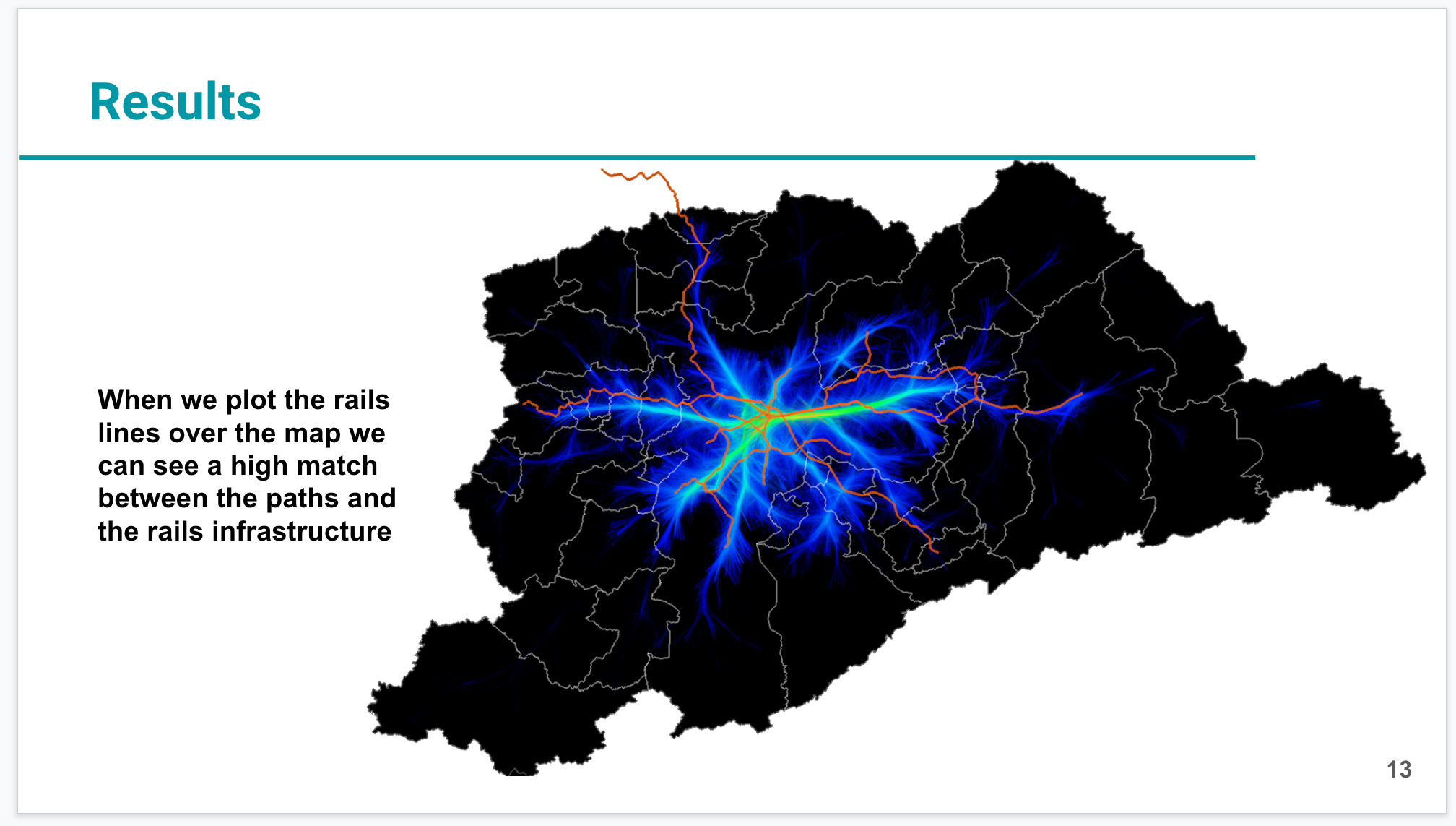
Bundling pattern referring to subway lines (“Visualization of Source-Destination data with Bundling”)
Higor Amario de Souza, Post-doc from IME-USP, presented the work “Analysing São Paulo Cycling Data”. Higor described results obtained within the BikeScience project, which aims to use data science to assist public policies related to the use of bicycles in cities. In addition to data from the Origin-Destination Survey, Higor also used data provided by bicycle-sharing companies in the city of São Paulo. Among the various results obtained with the research, Higor was able to describe the flows resulting from trips using bicycles at different times, which is useful information both for companies, as they can better define the number of bicycles to be made available in certain locations, and for managers, helping them in prioritizing renovations or construction of bike paths in the city.
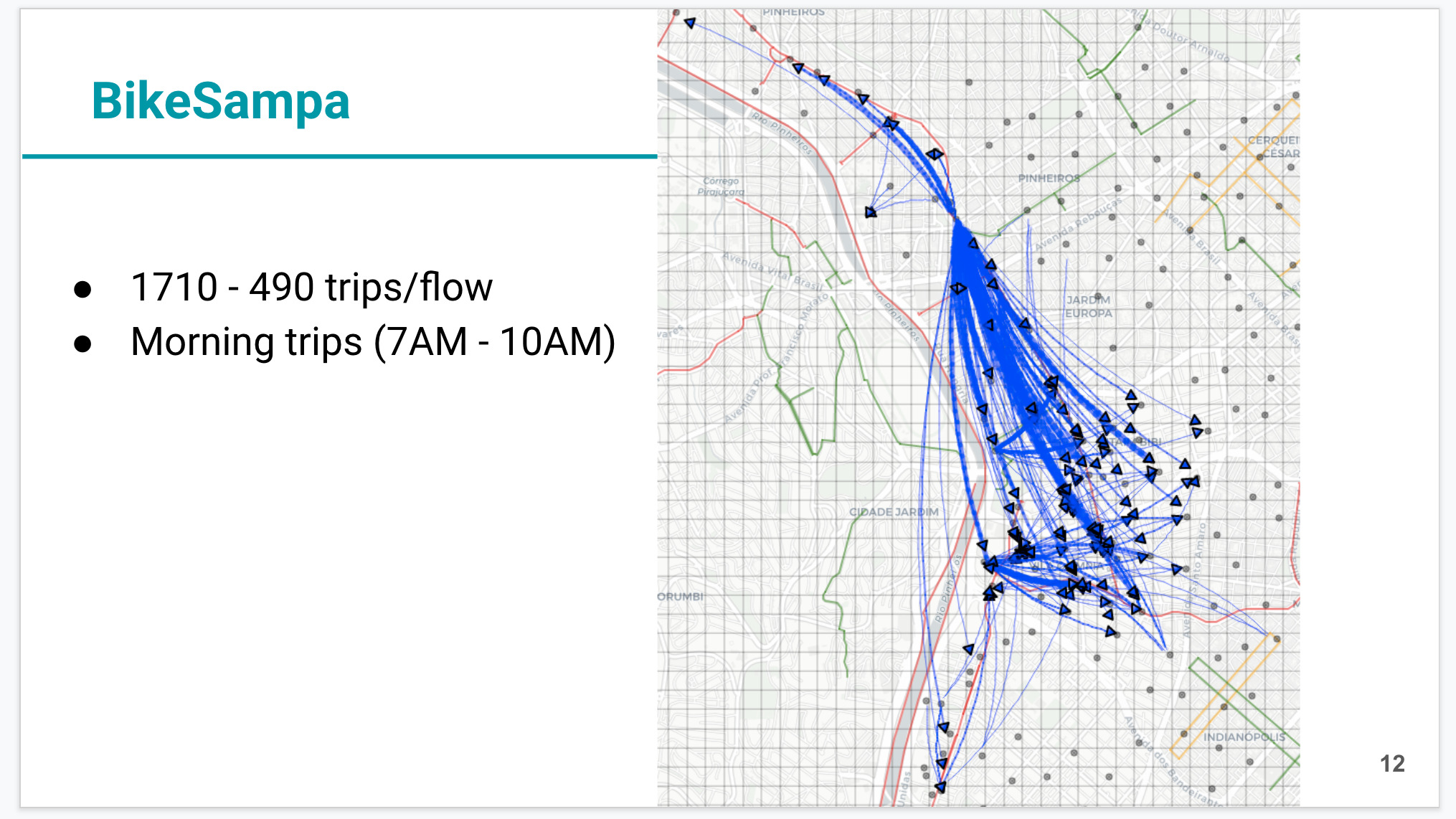
Flows created by BikeSampa trips in the morning (“Analysing São Paulo Cycling Data”)
The third presentation of the session was the work “Framework for real-time bus data processing”, presented by Ph.D. student Mayurí A. Morais, supervised by Professor Raphael Y. Camargo from UFABC. Mayurí justified the need for an open platform for real-time processing of data from urban bus systems. This platform would allow faster detection of anomalies in the operation of urban bus systems. Such faster detection may help reduce waiting times at bus stops and reduce congestion. As a result, Mayurí presented the platform architecture and the processing times obtained so far.

Architecture performance analysis (“Framework for real-time bus data processing”)
The fourth presentation, entitled “Monitoring of public transport emissions in the city of São Paulo”, was presented by Roberto Speicys Cardoso, founding partner of the company Scipopulis. Roberto showed the results obtained from a system developed with the objective of monitoring the atmospheric emissions generated by public transport. Among the various results presented, he highlighted those that showed some of the effects of the coronavirus pandemic in the city of São Paulo: reduction of carbon dioxide emissions, due to the reduction of the fleet, and increase in the average speed, due to the reduction of vehicles traveling in the city.
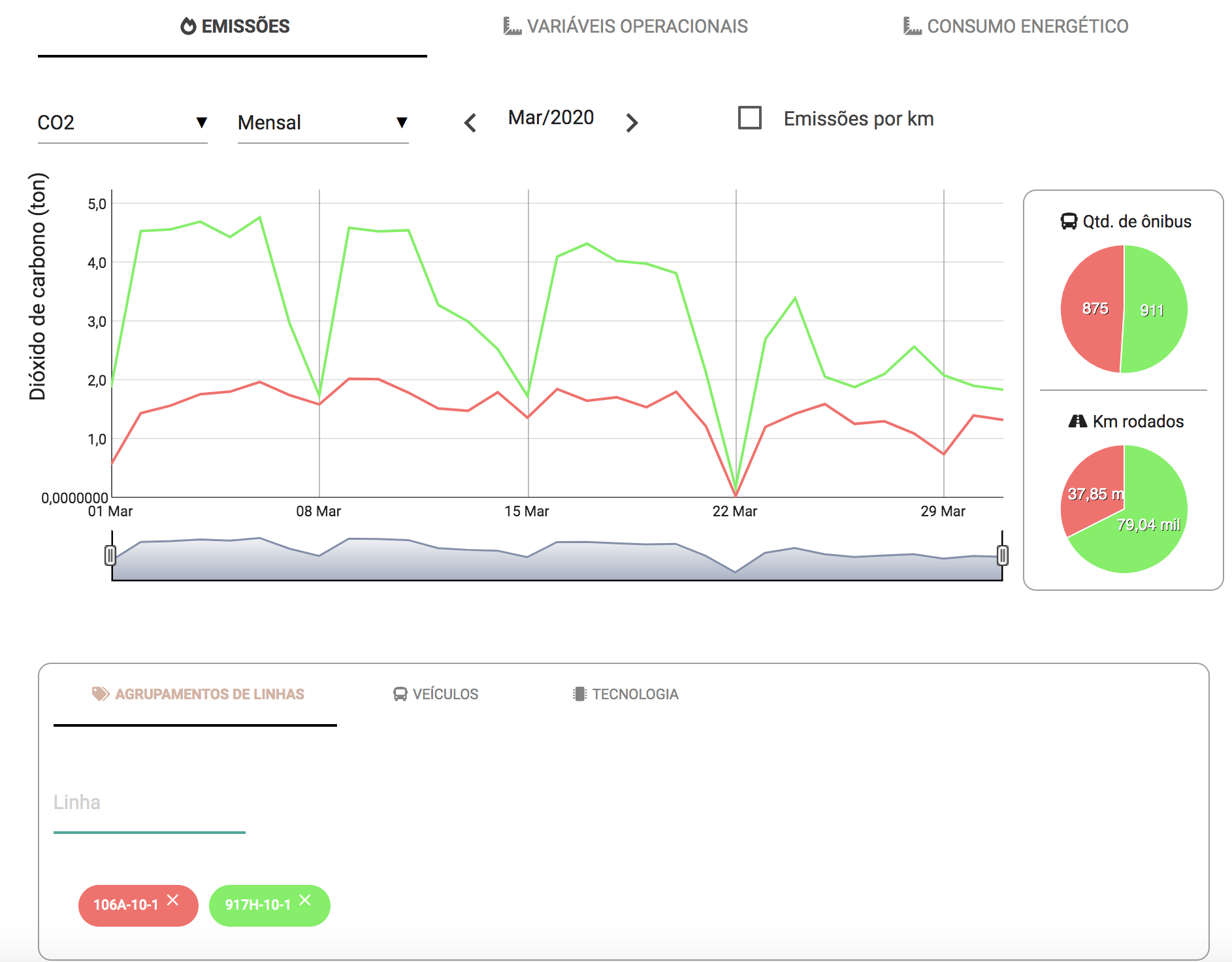
Carbon dioxide emission by buses in March (“Monitoring of public transport emissions in the city of São Paulo”)
The second session of the workshop, held on April 28th, was about computer networks and had 50 remote participants from 9 institutions.
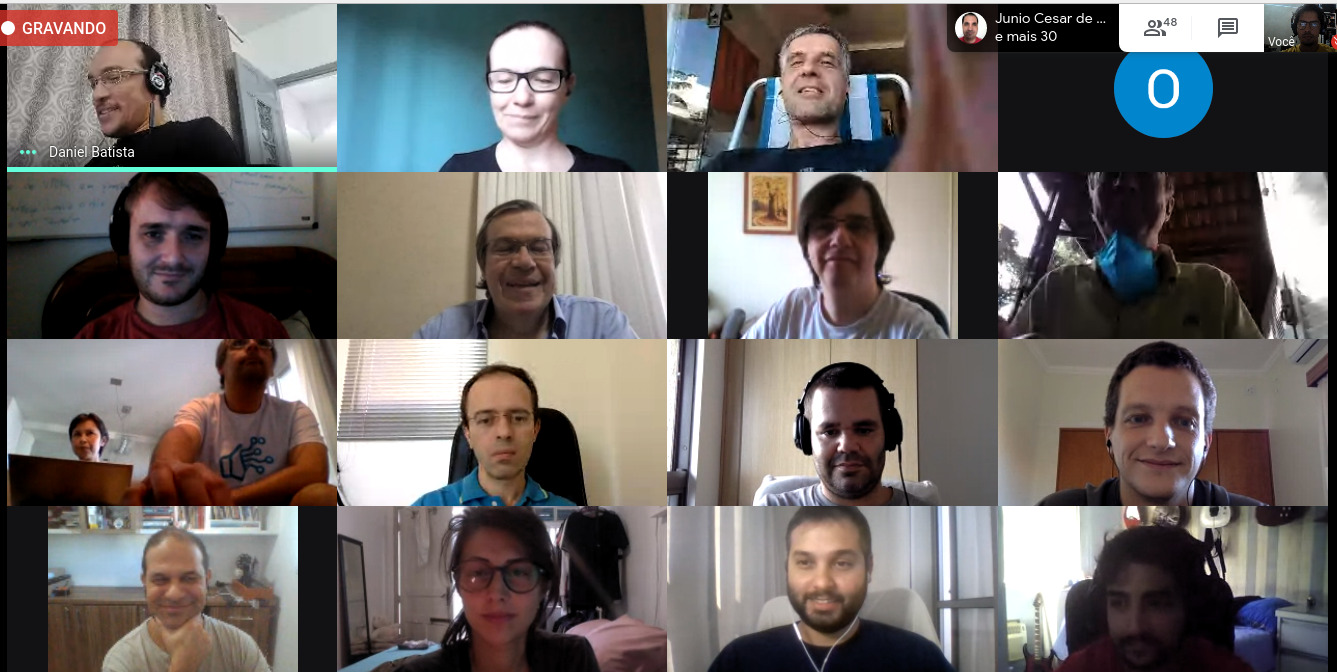
Some of the participants in the Second Session
The first work of the second session was “Microservice Placement in Multi-tier Cloud-to-Fog Networks”, presented by Masters student Fillipe dos Santos Silva, supervised by Professor Edmundo Madeira from Unicamp and co-supervised by Professor Roger Immich from UFRN. In his presentation, Fillipe highlighted the importance of using fog computing to guarantee the Quality of Service required by future multimedia applications on the Internet. In this scenario, an important decision concerns the choice of location in a city where microservices will be executed: Services closer to the user tend to offer lower latency, whereas services located farther away from the user can provide higher computational power. In the work, Fillipe presented good results when using a new placement algorithm based on the creation of a hierarchy between the devices of the computational fog.

Distribution of microservices across the network in a situation with high traffic intensity (“Microservice Placement in Multi-tier Cloud-to-Fog Networks”)
The second presentation, entitled “Network Slicing in the Fog to Support Mobile Users With Different Requirements”, was presented by Ph.D. student Diogo Machado Gonçalves, supervised by Professor Edmundo Madeira and co-supervised by Professor Luiz Fernando Bittencourt, both from Unicamp. Diogo showed good preliminary results that justify the use of network slicing to deal with the heterogeneity present in mobile networks. The effect on network quality metrics by users moving in vehicles at different speeds was highlighted.
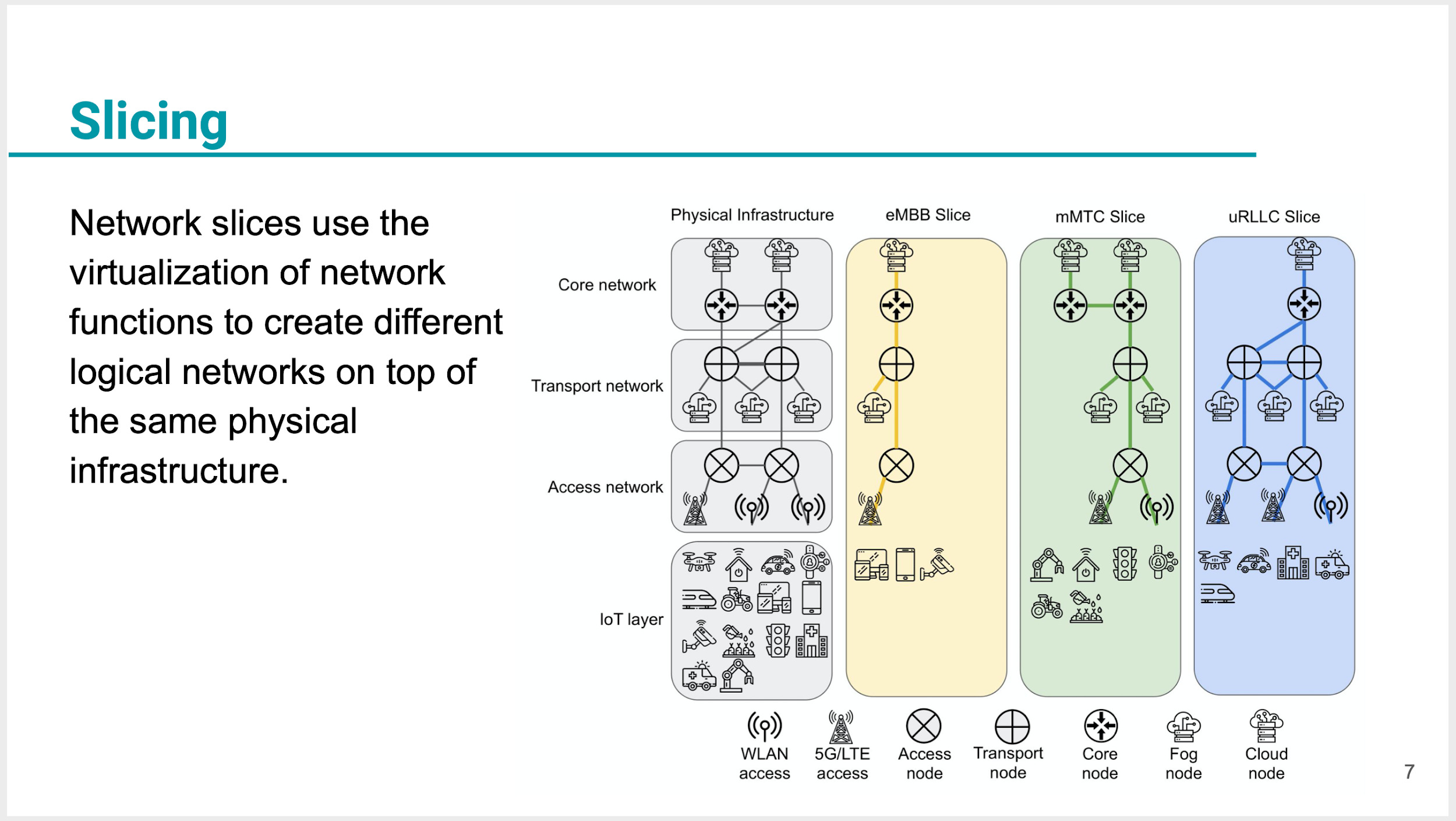
Illustration of using Network Slicing for three applications with different requirements (“Network Slicing in the Fog to Support Mobile Users With Different Requirements”)
Rodrigo Izidoro Tinini, Post-doc from UFABC, presented the work “Efficient Resource Management in 5G Optical Networks based on Cloud and Fog”. Rodrigo justified the importance of an architecture for 5G networks based on the use of cloud computing, together with fog computing, for the processing of the wireless network baseband signals. Optical networks play a fundamental role in this architecture, as they connect the baseband units, now virtualized, to remote radio heads. In comparison to architectures that use only cloud or only fog, the proposal presented by Rodrigo obtained a good balance between energy consumption, latency, and blocking probability.
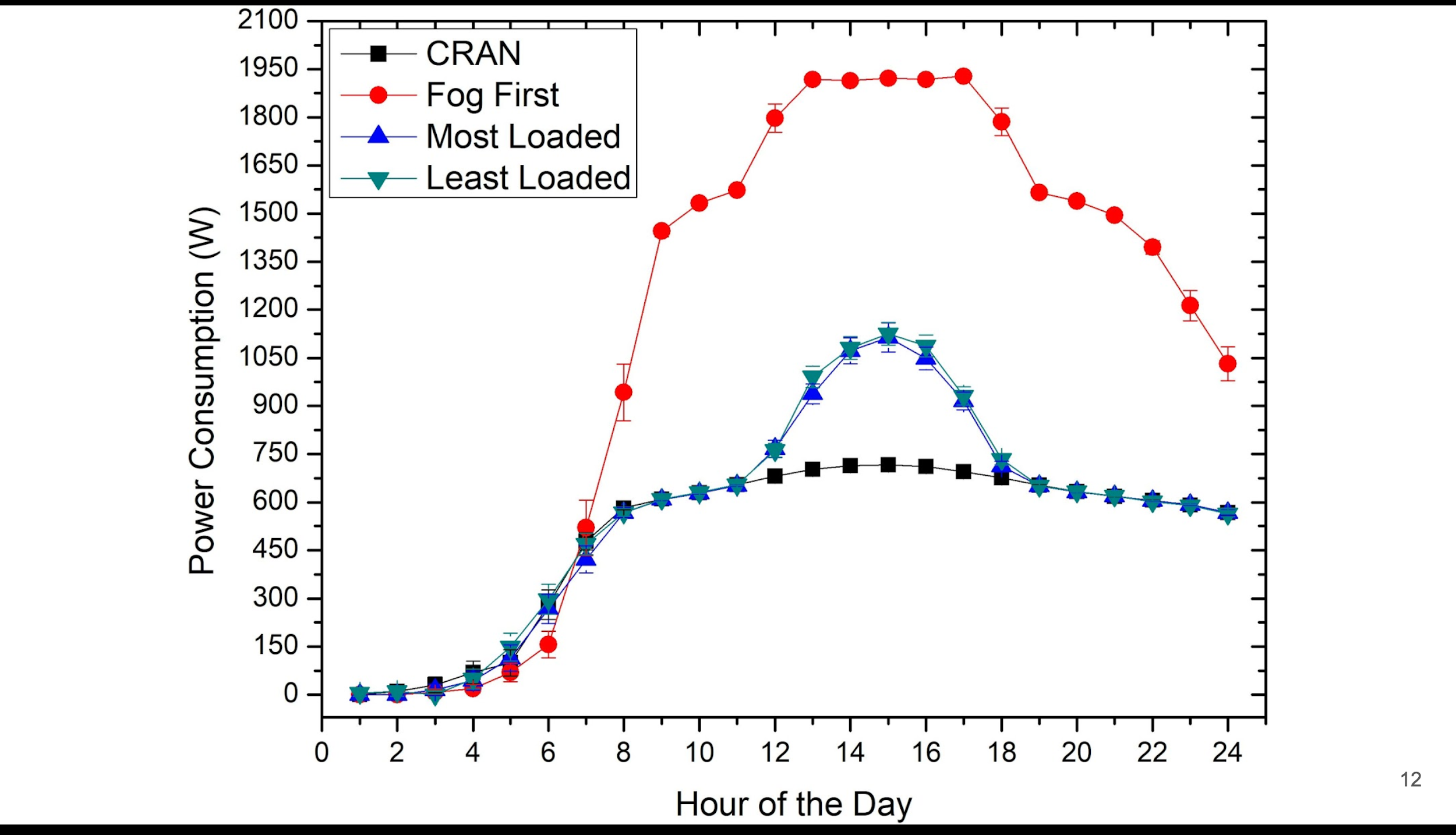
Power consumption of different architectures for 5G networks (“Efficient Resource Management in 5G Optical Networks based on Cloud and Fog”)
The fourth presentation of the Session, entitled “Federated Learning in Edge Computing for Real-Time Traffic Estimation in Smart Cities”, was presented by Masters student Matteus Vargas Simão da Silva, supervised by Professor Luiz Fernando Bittencourt from Unicamp. Matteus showed good results with the use of Federated Learning to predict the estimate of traffic on mobile networks. This prediction is useful for anticipating the allocation of network resources, increasing the quality of computational applications running on mobile networks.

Accuracy of Federated Learning in predicting traffic on mobile networks (“Federated Learning in Edge Computing for Real-Time Traffic Estimation in Smart Cities”)
The next scheduled workshop sessions are about Internet of Things Platforms (May 12th), Big Data and Cloud Computing (May 26th), and other topics such as citizen science and middleware (June 9th). Those works presented at the workshop with great interest to the general public will, in the coming months, be replayed as open lectures online. They will be publicized in advance.
The main sponsors and partners of the InterSCity project are CNPq, FAPESP, and CAPES. The project is carried out through collaboration between respected Brazilian educational and research institutions and companies.
Pesquisadores do projeto IoTrees, do InterSCity, desenvolveram protótipo que avalia condições microclimáticas de hortas e decide sobre quando e como adicionar água ao solo, e apresentaram o protótipo para diversos alunos em workshops durante os eventos Botânica no Inverno do Instituto de Biociências da USP e na Semana da Biologia da Universidade Federal de Juiz de Fora, em Minas Gerais.
Os participantes aprenderam conceitos iniciais sobre Hardware Livre, Internet das Coisas e Cidades Inteligentes: foram instruídos sobre como realizar coleta, armazenamento e análise de dados de experimentos, sobre como utilizar software e hardware livre em soluções do dia-a-dia, tiveram aula prática com modelagem e impressão 3D, além de programação com a linguagem R para análise de dados coletados.
O curso realizado no evento Botânica no Inverno durou duas semanas durante o mês de julho de 2019, com objetivo de instruir os alunos sobre tais tecnologias e também estimular o aperfeiçoamento do protótipo inicial, que coleta dados de sensores e os envia para uma plataforma online.
Neste curso os instrutores foram Janaina da Silva Fortirer e Antonio Deusany de Carvalho Junior, que uniram conhecimentos da área de Biologia e Ciência da Computação para criar o protótipo inicial e a documentação do mesmo, que foi publicada como capítulo de material didático no evento. Os participantes realizaram alterações no protótipo para que, além da coleta de dados, o protótipo fizesse uso de uma bomba d’água para regar uma mini horta de maneira inteligente. Os alunos também incluíram um sistema de envio de notificação para que o dono da horta receba em seu email informações sobre a horta e quando ela foi regada.
Os participantes foram os biólogos Carlos Celso Frazão Saraiva Júnior, Kessia Silva de Oliveira, Leticia Figueiredo Candido e Silvia Andrade Maia, e o ecólogo Luan Souza da Fonseca, que vieram dos estados Maranhão, Bahia, Paraná, Minas Gerais e Rio Grande do Norte. O protótipo final foi apresentado para o público presente no Botânica no Inverno, e ao chamar a atenção de outros participantes, resultou no convite para realizar já em novembro de 2019 o mesmo workshop, durante a Semana da Biologia da UFJF.
Nesse evento, realizado em Juiz de Fora, os participantes do curso anterior uniram-se aos instrutores iniciais para finalização de um novo material didático. Organizado com o auxílio de Lara Bacellar do Nascimento Rodrigues, co-participação de Pâmela Timóteo Patrício da Silva e Francisco Palmieri Montessi do Amaral que participaram do curso e auxiliaram com apoio técnico para sua concretização, este segundo workshop teve como participantes Leticia Hagale de Queiroz e Amanda Ribeiro de Faria. Realizado em 16hs ao longo de uma semana, foi possível finalizar o protótipo novo e identificar pontos para aprimorar o material didático.
Estes eventos serviram para divulgação de muitos conhecimentos, além de mostrar que a integração das diversas áreas da ciência pode ser útil e proveitosa. Ao vencerem certa resistência aos conteúdos de Ciências da Computação, os alunos de Ciências Biológicas progrediram no geral e no fim foi possível demonstrar como tais tecnologias podem ser aplicadas no seu cotidiano e suas pesquisas.
Os instrutores também tiveram a possibilidade de perceber como os conceitos ministrados foram compreendidos, já que seus alunos iniciais participaram como instrutores no segundo curso, disseminando conhecimento adquirido, o que foi de grande valor para todos.
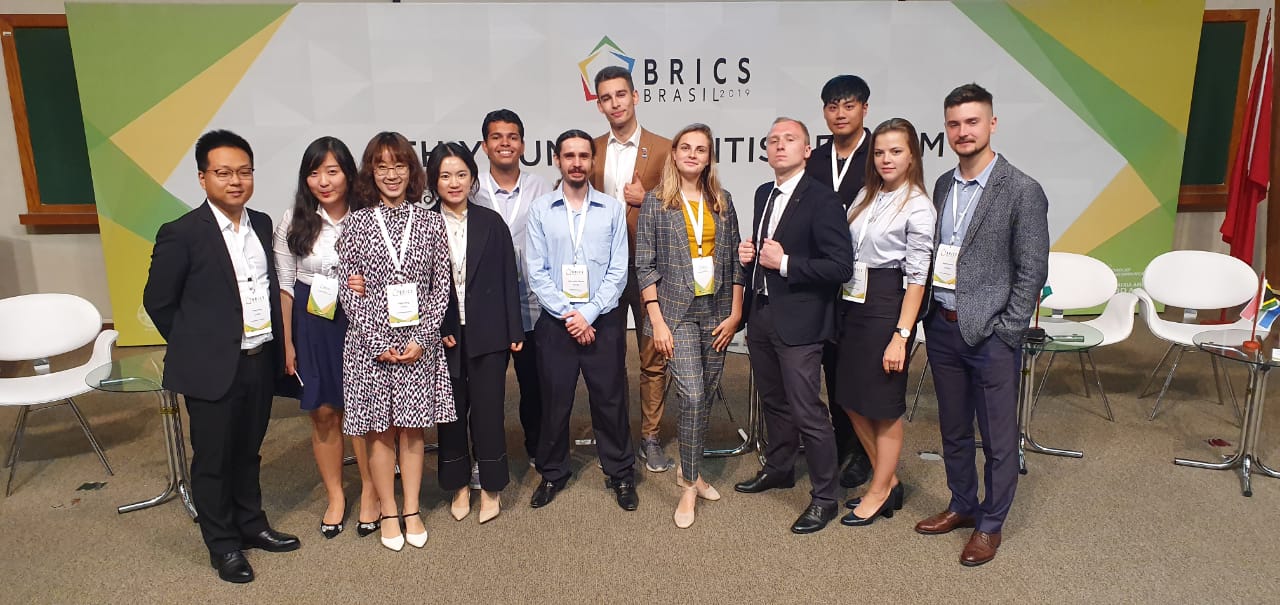
The INACITY project (INvestigate and Analyse a CITY) was selected to be one of the finalists competitors of the 2nd BRICS Young Innovator Prize, awarded to recognize the top research, development and innovation projects that can contribute majorly to the science and technology sectors and gathered scientists from all the BRICS nations, in the event that is part of the 4th BRICS Young Scientist Forum that happened in Nov 6th, 2019.
The INACITY project is developed by members of the InterSCity Project, the Professor Roberto Hirata Jr and Artur André A. M. Oliveira PhD, both from the Institute of Mathematics and Statistics, of the University of São Paulo.
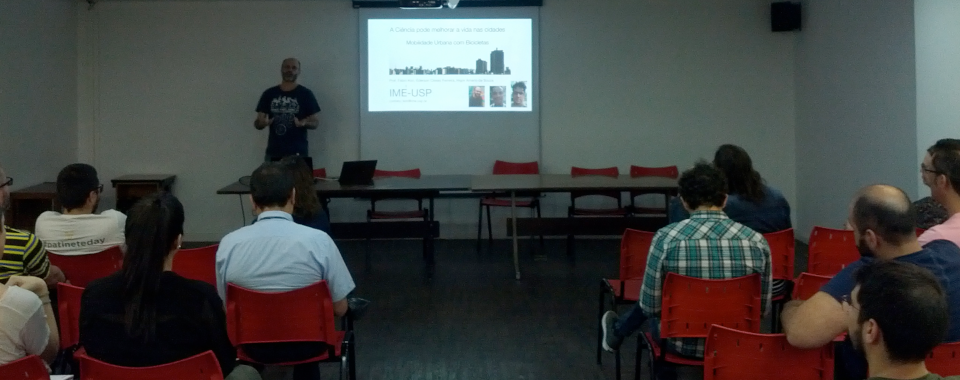
BikeScience, an open-source tool for the analysis of bicycle mobility, developed within the InterSCity project, is being adopted by the São Paulo Traffic Engineering Company (CET). CET will use BikeScience to analyze and plan the cycling infrastructure of the city of São Paulo.
This is one of the first collaboration and technology transfer results between the InterSCity project and governing bodies of the city of São Paulo. In addition to using the tool, the cycling system planning teamwill interact with the researchers to implement new analyses of the city’s bicycle system as well.

INCT Project Coordinator, professor Fabio Kon
BikeScience uses data from bicycle sharing systems as well as data from the Origin-Destination survey conducted by Companhia do Metropolitano de São Paulo (the company that operates the city’s subway system). The tool started as part of Professor Fabio Kon’s research during his visit to the Senseable City Lab, a research group from the Massachusetts Institute of Technology (MIT), with the collaboration of researchers Fabio Duarte, Paolo Santi, and Carlo Ratti. Other members of the project are Éderson Ferreira, a Computer Science undergraduate student at the Institute of Mathematics and Statistics of the University of São Paulo, Higor de Souza, and Eduardo Santana, researchers of the InterSCity project.
In addition to CET, companies that operate bicycle sharing systems, such as TemBici (BikeSampa) and Grow (Yellow), also have been important partners in providing data that allows the analysis of bicycle trips in São Paulo. More information about BikeScience can be seen in the project repository.
Radartona was a Hackathon for the development of mobility solutions for the city of São Paulo, using data from the 900+ radars installed in the city. In addition to the radar data, a large amount of city data was also available, such as information on traffic accidents, weather, and the average speed of city buses. The event was held at Mobilab+ (http://mobilab.prefeitura.sp.gov.br/) on November 8-10.
Radartona proposed six challenges for the development of solutions: average radar-detected speed, accuracy of climate radars, anonymization of radar data, relationship between climate and radar data, relationship between bus GPS data and radar data, and relationship between accidents and radar data.
The InterSCity team was composed by researchers Higor Amario and Eduardo Santana (FAPESP fellows) and undergraduate student Éderson Cássio (CNPq fellow). The proposal was to verify whether radar placement influences accidents in the city. The group found out that accidents usually occur outside the radar’s area of influence, indicating that the presence of radars prevents accidents. More information about the project and the code developed can be found in the project repository.
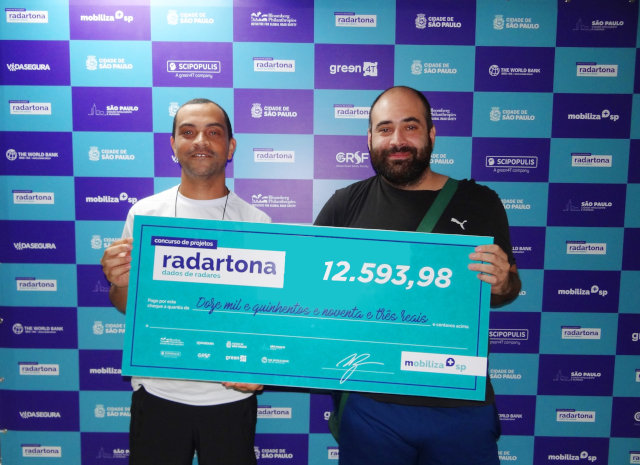
Higor Amario and Eduardo Santana (FAPESP fellows)
TV local show (in portuguese): click here to watch
Article: download
MIT scientist Fabio Duarte conducted a graduate course on Urban Science at IME-USP.
The course was based on recent literature on Urban Science, AI, and Autonomous Vehicles published in the Nature and Science journals.
The contents were highly interdisciplinary and attracted 35 graduate students from Computer Science, Architecture, Urban Planning, Engineering, Physics, and Social Sciences. Staff members from the City of São Paulo, IPT, and SERPRO, the Brazilian Public IT Company, also participated.
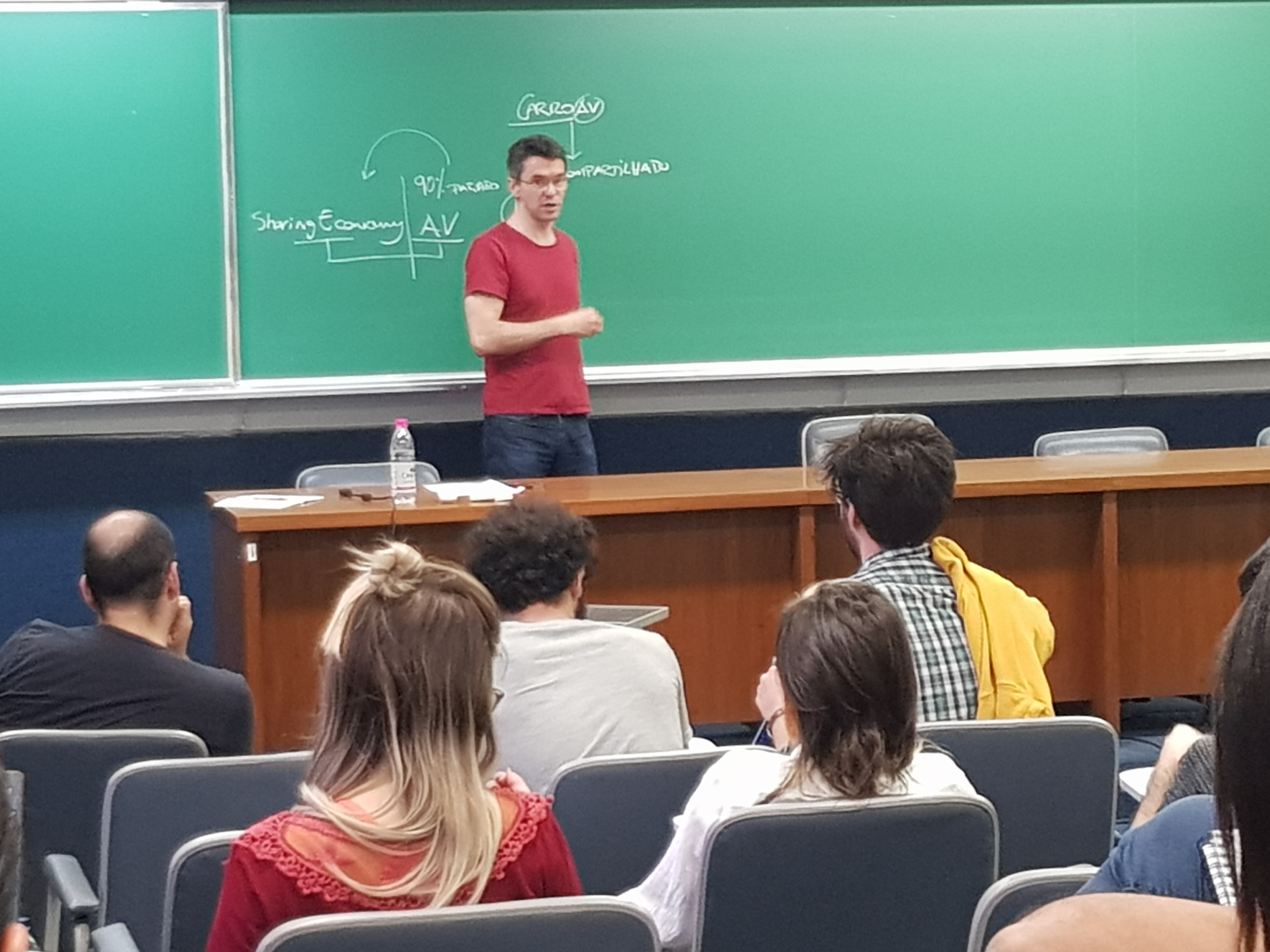
Short-bio: Fábio Duarte is a Research Scientist at MIT Senseable City Lab, a professor at PUCPR, Brazil. Fábio is interested in how can we use technologies to reimagine our cities. At MIT Senseable City Lab, he manages several projects — from deploying small robots into the sewage to building a fleet of autonomous boats to Amsterdam. Fábio is the author of Unplugging the City (Routledge, 2018).
The paper “Evaluating Exclusive Lanes for Autonomous Vehicle Platoons” authored by Gustavo Covas, Eduardo, and Fabio Kon won the best student paper award in the ECMS International Conference on Modelling and Simulation in the city of Caserta, Italy. The paper was presented 14/06/2019 by Eduardo Santana.
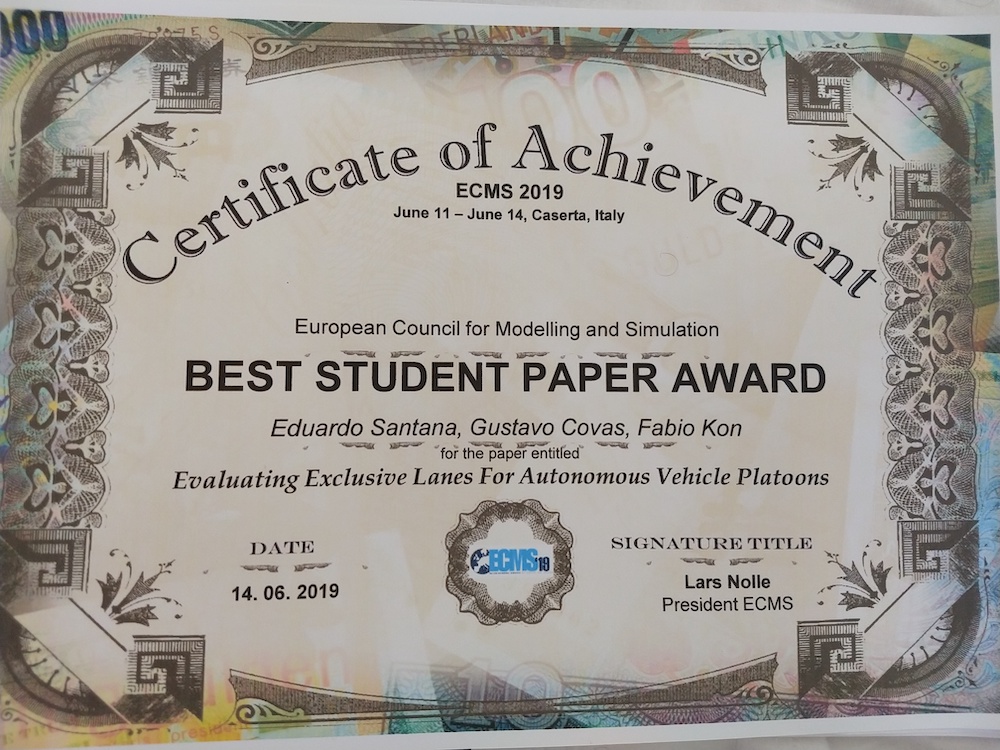
You can download the paper here.

De 15 a 17 de abril aconteceu, em Juquehy-SP, a segunda edição do Workshop do Projeto InterSCity – Instituto Nacional de Ciência e Tecnologia (INCT) da Internet do Futuro para Cidades Inteligentes. Tal projeto tem como principais patrocinadores e parceiros o CNPq, a FAPESP e a CAPES e é executado a partir da colaboração entre respeitadas instituições de ensino, pesquisa e empresas brasileiras.
Foram três dias intensos de apresentações de projetos de pesquisa, discussões, reflexões e muita troca de conhecimento. O evento contou com a participação de aproximadamente 50 pesquisadores, de diferentes regiões do país e do mundo, desde estudantes de graduação, pós-graduação (mestrado e doutorado) até experientes especialistas da academia e da indústria.
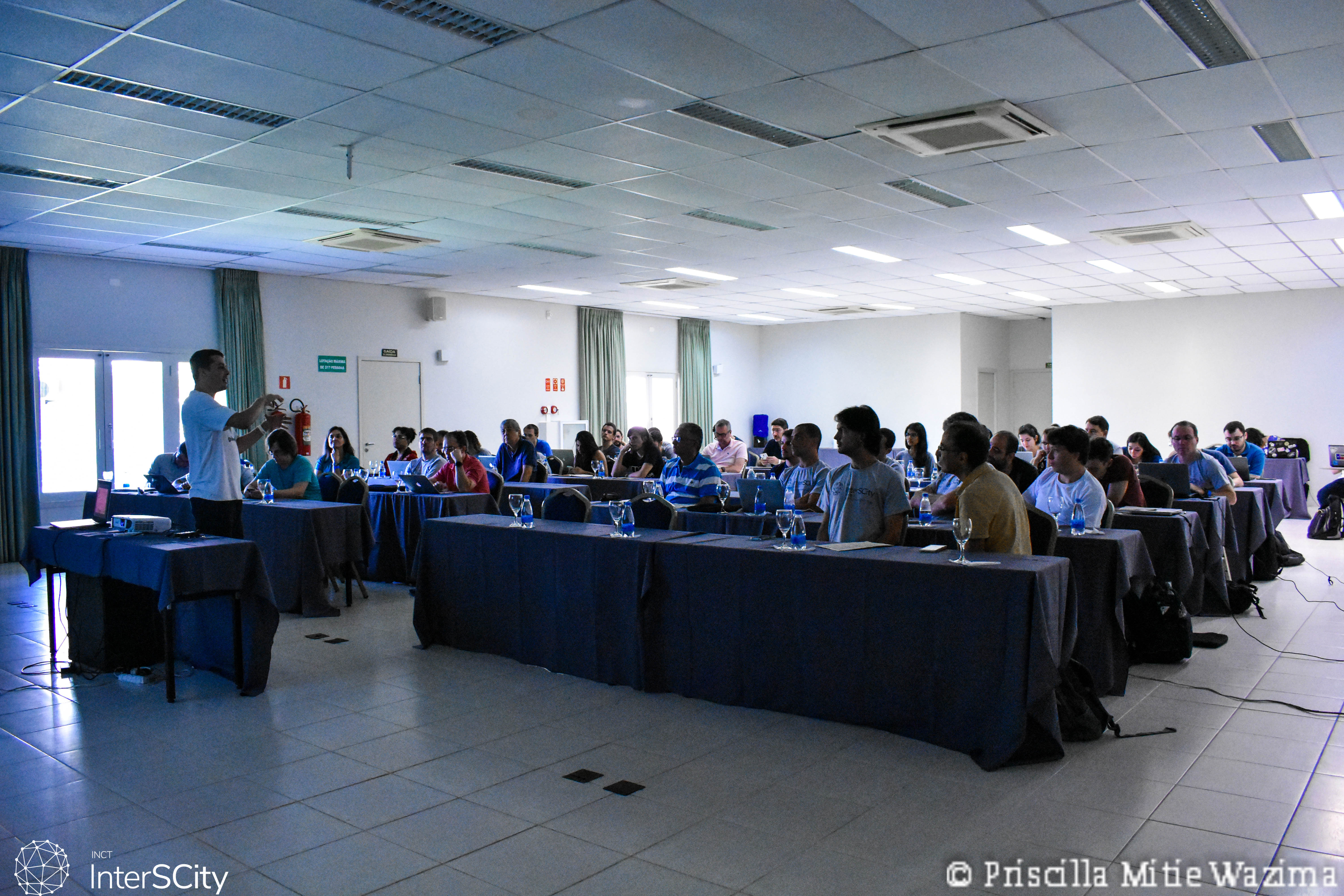
Durante o evento, os participantes apresentaram e discutiram as pesquisas em andamento e possibilidades de projetos futuros. De forma geral, os projetos apresentados estavam relacionados a temas como saúde, meio ambiente, mobilidade/transporte, acessibilidade, educação, arquitetura e urbanismo, desenvolvimento e melhoria de plataformas e tecnologias como internet das coisas, computação em nuvem, aprendizado de máquina e big data.

Apesar da maior parte da programação acontecer em um auditório, também foram realizados debates durante caminhadas na praia e descontraídas refeições. A programação completa do evento, apresentações e fotos estão disponíveis em: http://interscity.org/meetings.
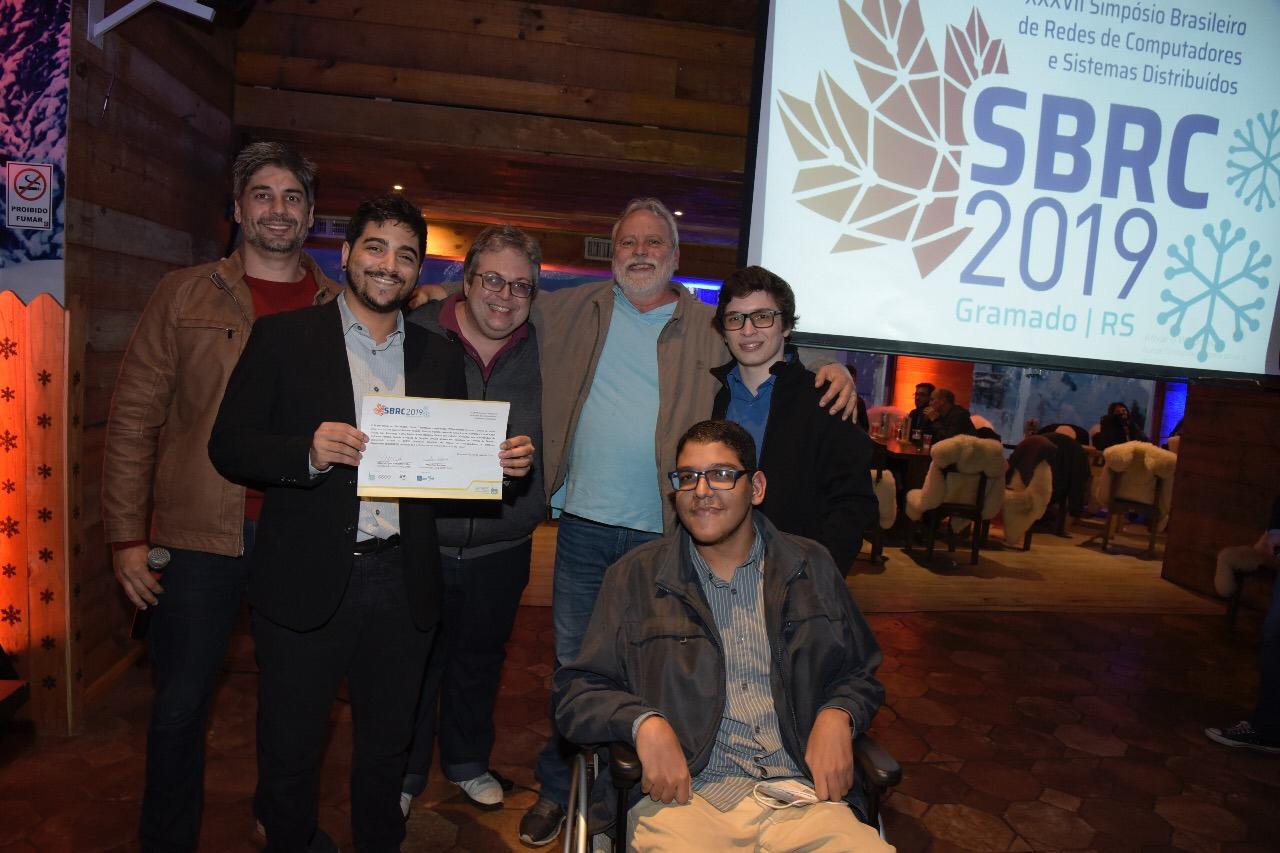
The GTA/UFRJ team, headed by Prof. Otto Carlos, developed a blockchain-based system for providing security to virtualized networks and network slicing, ensuring auditability, non-repudiation, and integrity of orchestration operations. The work developed by the team of Prof. Duarte was recently awarded the “Best Paper Award” for the paper “Provendo uma Infraestrutura de Software Fatiada, Isolada e Segura de Funções Virtuais através da Tecnologia de Corrente de Blocos” during the II Workshop em Blockchain: Teoria, Tecnologias e Aplicações (WBlockchain’2019) of the XXXVII Simpósio Brasileiro de Redes de Computadores e Sistemas Distribuídos (SBRC’2019). This is the second year in a row that the team lead by prof. Otto wins the award. The success of this research is due to the work of Gabriel Antonio F. Rebello, Gustavo F. Camilo, Leonardo G. C. Silva, Lucas C. B. Guimarães, Lucas A. C. Souza and Igor D. Alvarenga, who co-authored the paper and participated in Prof. Otto Carlos Duarte’s team.
For more information about the work, including the full paper and related publications, please access https://www.gta.ufrj.br/publicacoes.
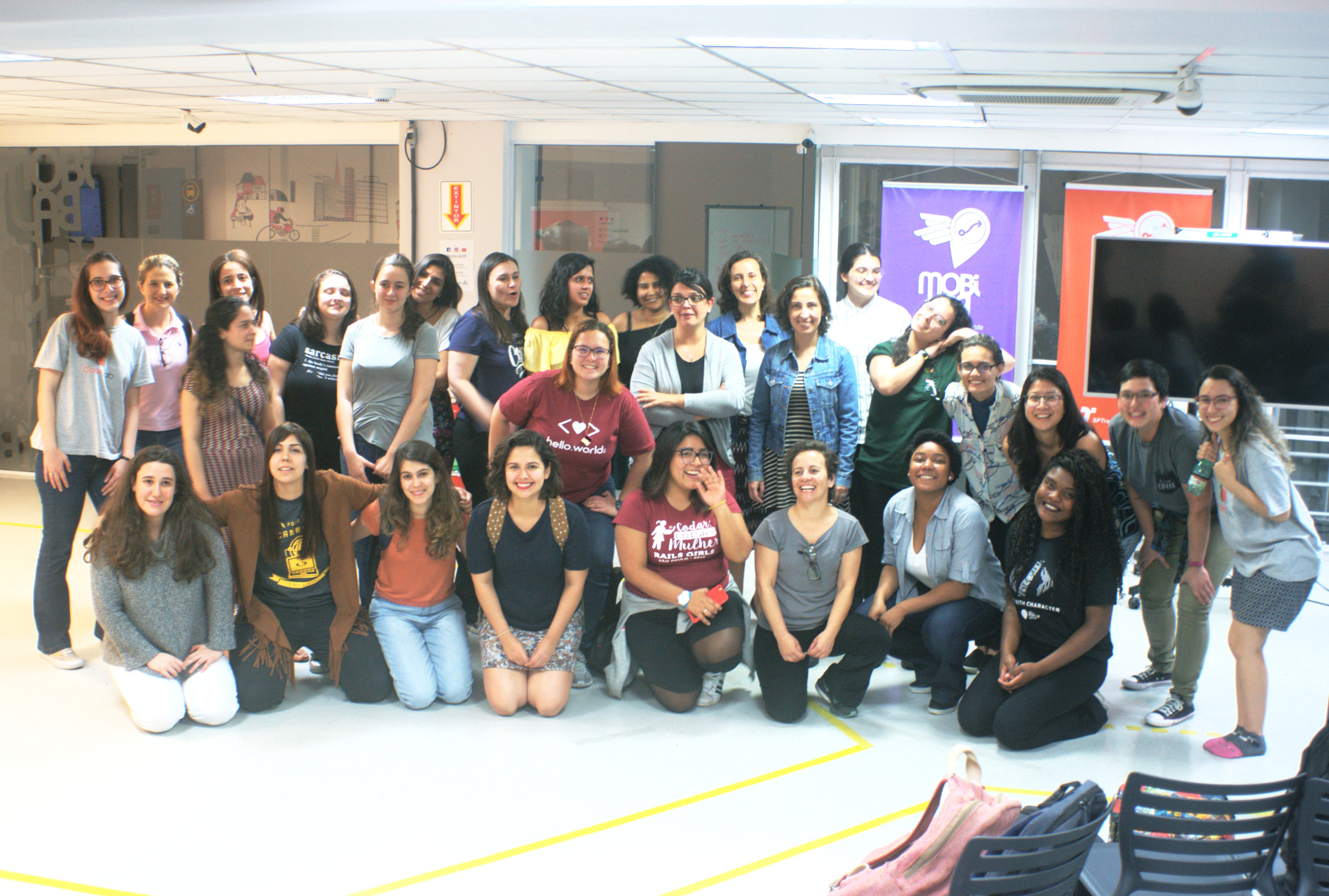
In the last sunday (09/02/18), the HackMobility2018 event took place in downtown São Paulo.
The hack day event hosted 21 participants, all women, and aimed to analyze data related to urban mobility in São Paulo to propose solutions that contribute to a more accessible city for pedestrians and cyclists. For this purpose, the participants had access to several datasets of city departments, such as the Health Secretariat, the Traffic Engineering Company (CET), São Paulo Transportation department (SPTrans), among others. These datasets include information such as traffic accidents, traffic tickets, hospital care and deaths.
The event was conceived and organized by USPCodeLab , the Ciclocidade and InterSCity, and was supported by Yellow . The HackMobility2018 happened in the São Paulo’s Laboratory of Innovation in Mobility (MobiLab).
During the 10 hours of the event, the participants, organized into 5 teams, developed their ideas and solutions for mobility. Most of the teams focused on public safety issues, which shows that this is one of the main concerns related to mobility in São Paulo, especially for women.
At the end of the event, the teams presented their proposals and were evaluated by a judging committee composed of Ana Carolina Nunes, director of Cidadeapé, Haydee Svab, researcher in Urban Mobility and Graziela Tonin, professor and researcher in Software Engineering at the Federal University of the Border South.
The winning proposal was the Friend Tip app, proposed by Iara Pereira, Jéssica Rocha, Lais Aguiar, Michelle Tanaka and Nataly Gonçalves. Friend Tip traces safer routes for cyclists. In addition, the app identifies users who make similar routes to suggest friends for group travels. Friend Tip uses data of accidents in São Paulo and the São Paulo cycling routes to identify the most dangerous routes. The winning team members received R$ 200.00 in credits for using Yellow bikes, while the other participants received credits of R$ 50.00 each one.
When: Friday, August 3rd, 2018 3:00-4:30PM
Speaker: João Marcos Barguil (IME-USP)
Abstract: In Brazil and around the world, there are millions of people with various deficiencies. Besides, an aging population is a worldwide tendency, which implies a growing number of seniors in society, with diverse kinds of functional and cognitive limitations. Finally, women in the final stages of pregnancy, small children, or people without deficiencies but with temporary limitations, all benefit from Accessibility. But what is Accessibility? In this presentation, we explore this subject and investigate how Information Technology may be used to help people study, work, or simply leave their homes.
Short-bio: Engineer and Master in Computing by the Polytechnic School at USP, currently a Computer Science PhD candidate at IME-USP and responsible for the technology behind guiaderodas, a collaborative mobility guide for people with ambulatory difficulties, which was chosen by the UN in 2016 as the best digital initiative worldwide for inclusion and enpowerment. Former Slush ambassador, the largest entrepreneurship and innovation event in Europe, has also worked with tecnnology and innovation in Uganda, in partnership with the UNICEF, and in Finland.
The presentation will be streamed at https://www.youtube.com/watch?v=D_lTq7W1LfQ
The paper “SINFONIA: Gerenciamento Seguro de Funções Virtualizadas de Rede através de Corrente de Blocos” co-authored by f Gabriel A. F. Rebello, Igor Drummond Alvarenga, Igor Jochem Sanz, and Otto Carlos M. B. Duarte has won the best paper award in I Workshop em Blockchain: Teoria, Tecnologias e Aplicações (WBlockchain’2018) of the XXXVI Simpósio Brasileiro de Redes de Computadores e Sistemas Distribuídos (SBRC’2018). The GTA/UFRJ team, headed by Prof. Otto Carlos Duarte, developed SINFONIA (Secure vIrtual Network Function Orchestrator for Non-repudiation, Integrity, and Auditability), a blockchain-based system for providing security to virtualized networks, ensuring auditability, non-repudiation, and integrity of orchestration operations.
For more information about SINFONIA, access https://www.gta.ufrj.br/sinfon
For the full paper and related publications, access https://www.gta.ufrj.br/public
The members of the group Hardware Livre USP, after the successful participation in the Campus Party Brasil 2018, were invited to perform at Arduino Day with the EscovandoBits workshop.
The workshop will take place at Praça das Artes at 10am on 12/05/2018.
For more information: https://arduinodaysp.splashthat.com/
Speaker: Wellington Oliveira (CIN/UFPE).
When: Monday, May 14th, 2018, 10:00 AM.
Where: Auditório do CCSL-IME/USP.
Speaker: Ciro Biderman (FGV-SP)
Abstract: We analyze the impacts on the urban form of a large Brazilian public housing program—Programa Minha Casa Minha Vida (PMCMV). Our aim in this paper is to determine whether the program impacts urban sprawl and its trend. We analyze 18 metropolitan areas using satellite images and other datasets to compare municipalities where the program was more intense with municipalities where the program produces housing below the median. First, we compare the urban footprint in 2005 and 2015. Second, we compare the trend from 1995 to 2005 with that from 2005 to 2015. The conclusion is that the program itself has no significant impact on urban sprawl. However, the number of units built does have an impact on the spatial pattern of the urban footprint. Cities were infilling faster before the program was implemented. The program is currently under revision and we suggest that it can be improved by shifting the incentives to converge to more centralized development of the land leading to more compact cities.
When: Friday, March 23th, 2018, 9:00 AM.
Where: Sala H-312C, GTA/UFRJ.
The objective of this presentation is to introduce the new paradigm that will be used from 2020: the “Plug &Network” concept. This concept allows to derive new network architectures ranging from a completely centralized architecture to a fully distributed solution. We will examine the pros and cons of these different architectures to try to imagine architectures that should be deployed in the 2020s.
Dr. Guy Pujolle – Université Pierre et Marie Curie (UPMC).
When: Thursday, March 22th, 2018, 12:00.
Where: Sala H-312C, GTA/UFRJ.
The objective of this seminar is to examine new solutions for securing data networks and the solutions that will be implemented in the short and long term. We will examine the solutions based on secure elements, Cloud of security, blockchain, new generation firewall, big data, machine learning, etc. We will look at how to implement them in the four major network architectures for the 2020s that will integrate 5G, slicing, orchestrators and controllers.
Dr. Guy Pujolle – Université Pierre et Marie Curie (UPMC).
During the summer program at IME-USP, 4 projects were developed in the Smart Cities discipline:
The presentation video can be found at https://www.youtube.com/watch?v=HDvcfhyaT0c

The GTA/UFRJ team, headed by Prof. Otto Carlos, developed the tool called “CATRACA: a scalable traffic classifier and analyzer” for analyzing big stream data and classifying in real-time threat from normal network traffic. The work developed by the team of Prof. Duarte was recently awarded with the “Best Tool Award” during the Simpósio Brasileiro em Segurança da Informação e de Sistemas Computacionais (SBSeg’2017). Moreover, the research has been going on for two years and it was also awarded with the “Best Paper Award” of the 1st Cyber Security in Networking Conference (CSNet’2017) on October 2017, with the paper “Collecting and Characterizing a Real Broadband Access Network Traffic Dataset”. Success of the research is acknowledged to a joint work of the Prof. Otto Carlos Duarte’s team, Martin Andreoni, Antonio Lobato, Igor Alvarenga, Gabriel Rebello, Igor Sanz, and Diogo Mattos, with the Prof. Guy Pujolle (LIP6/UPMC – Paris, France).
For more information about CATRACA, access https://www.gta.ufrj.br/catrac
When: Friday, December 15h, 2017, 3:00 PM.
Speaker: Rodrigo Izidoro Tinini (IME/USP).
Abstract: In the context of future Cloud Radio Access Networks (CRAN), optical networks will play an important role to provide the required transport capacity between cell-sites and processing pools, especially for future 5G scenarios. For instance, using CPRI fronthaul technologies a single antenna element can generate data up to 24.3Gbps even with current configurations of radio transmissions, and it is expected to generate up to Tbps with the advance of technology. So, the transport segment of a 5G network needs to be accurately planned to accomodate all the generated traffic. In this work, we propose the use of a Passive Optical Network jointly with the emergent paradigms of Fog Computing and NFV to energy-efficiently support the high traffic transported in emergent mobile networks in an hybrid architecture called Cloud/Fog RAN (CF-RAN) that allows local and remote baseband processing. We introduce an Integer Linear Programming (ILP) model to schedule the processing of CPRI demands among the processing nodes of the network and turn on or off processing functions on demand. Our approach is able to accomodate demands on the nodes of the network in the most energy efficient way. We compare our results with CRAN and distributed architectures (DRAN) and show that an energy efficient planning can achieve considerable gains in energy consumption.
Aplicativos arrumam caronas e rotas de transporte; conheça os melhores em https://noticias.r7.com/tecnologia-e-ciencia/apps-modernos-mostram-como-a-tecnologia-transformara-as-cidades-23112017
When: Friday, November 24th, 2017, 4:00 PM.
Where: Anfiteatro do Centro de Informática da UFPE.
Assista o vídeo completo do painel em https://www.youtube.com/watch?v=YJLz3wcbjV0&feature=youtu.be&t=6m
Moderador: Alfredo Goldman (IME-USP e INCT InterSCity)
Claudio Pinhanez (Computação Cognitiva – IBM Research São Paulo)
Marcelo Finger (IA – IME/USP)
Pedro Henrique Ramos (Direito Digital – Batista Luz Advogados)
Luli Radfahrer (Comunicação – ECA/USP)
Gabriel Poli Figueiredo (Arquitetura e Urbanismo – FAU-USP)
Todos os interessados são bem-vindos!

Semana Nacional de Ciência e Tecnologia.
Quando: Quinta-feira, 26 de Outubro às 10h.
Onde: EACH | USP (Auditório Verde).
As atividades de mobilidade urbana, como a operação de serviços de transporte público, são grandes produtoras de dados. Parte desses dados é disponibilizada pela prefeitura de São Paulo como dados governamentais abertos, o que também demonstra a importância da mobilidade urbana para políticas de governo aberto e transparência governamental. O painel ora proposto pretende apresentar as possibilidades de aperfeiçoamento, uso e publicação de dados sobre mobilidade urbana referentes ao município de São Paulo.
Semana Nacional de Ciência e Tecnologia.
Quando: Sábado, 28 de Outubro às 9h.
Onde: Centro de Difusão Internacional da USP.
O grupo Hardware Livre apresentará seus projetos desenvolvidos ao longo dos anos envolvendo placas como Arduino, Raspberry Pi e Intel Galileo, além de soluções utilizando impressora 3D, Internet das Coisas e interfaces musicais. Os participantes poderão interagir com os projetos que vão desde protótipos de soluções científicas a vídeo games. Dentre os projetos apresentados, teremos uma potente mini centrífuga, um cluster de hardware livre, o Genius, e um teclado de drivers de disquetes. Todos os projetos apresentados são livres e podem ser reproduzidos por quem tiver interesse.
Prof. Otto Duarte, InterSCity member, will be the General Chair of the 1st Cyber Security in Networking Conference.
Prof. Alex Telea offered a presentation on how to unify scientific visualization (SciVis) and information visualization (InfoVis).
When: Thursday, September 28th, 2017, 2:00 PM.
Where: Auditório Jacy Monteiro, IME- USP.
Abstract: For decades, scientific visualization (SciVis) and information visualization (InfoVis) have been related, but still distinctly separated disciplines. Methods and techniques in the two areas have developed relatively separately, causing an arguably unnecessarily separation in the visualization field. Attempts for unification exist, but are largely based on heuristics, and subject to critique from both the SciVis and InfoVis angles. In this talk, we argue that this separation is not necessary, and, up to large extents, artificial. More specifically, we argue that the difference between SciVis and InfoVis is not a matter of design decisions only, but, more centrally, a matter of representing the structure of large data collections by means of smooth, continuous, encodings. We present a way to cast InfoVis along the same principles as the more classical SciVis, based on a continuous, multiscale, spatial representation of data. Putting it simply, we argue that visualizing large amounts of InfoVis data can use encoding techniques which share the same continuity and multiscale principles as most classical spatial SciVis (or image processing) methods use. In turn, we show how this is possible by means of defining appropriate similarity metrics and encoding principles for InfoVis data. This leverages a wealth of data simplification, encoding, and perception principles, since long available for SciVis data, for the richer realm of InfoVis data. We demonstrate our image-based paradigm by examples covering the visualization of relational, multidimensional, and time-dependent InfoVis data.
Mini-bio: Prof. Alex Telea has obtained his PhD in data visualization at the University of Eindhoven in 2000, where he worked next as assistant professor in the same field until 2007. Since then, he is full professor of multiscale visual analytics at the University of Groningen, the Netherlands. His research interests are at the crossroads of multiscale image and shape processing and information visualization and visual analytics. He has published over 200 papers on the above topics, and is the author of the textbook ‘Data Visualization — Principles and Practice’ (CRC Press, 2008, 2014).
On September 29th, 2017, Ricardo Massa Ferreira Lima presented the REFlex Water engine.
Abstract: This project proposes the conception of a novel water management framework, called REFlex Water, that uses declarative business processes to specify the management policies and to control the actions of water managers. The main component of REFlex Water is the REFlex Rule Engine, which analyzes the rules of the declarative business process to identify inconsistencies or threats to the correct execution of the process. The engine controls the process execution, avoiding conflicts (deadlocks or livelocks) and the state space explosion observed in the existing engines. The REFlex Water framework integrates three main technologies: (1) IoT infrastructure for water management systems; (2) the REFlex Rule Engine for executing declarative processes; (3) CEP (Complex Event Process) Engine for interpreting great amount of sensors data in real time. Many works has addressed the first technology. This project innovates in integrating these three technologies into a single water management framework. We believe that declarative processes can provide the desired freedom the water managers need to perform their daily controlling activities, which relies mostly on their experience, but keeping the control over strict water policies. Likewise, the CEP engine brings the capacity for compiling signals from a complex network of sensors into a contextual water management information in real-time. Therefore, we expect to produce a complete solution for the efficient and safe management of complex water systems.
Mini-bio: Ricardo Massa Ferreira Lima is an assistant professor at Informatics Center of the Federal University of Pernambuco. Ricardo received his PhD degree in computer science from Federal University of Pernambuco, in 2000. He was a post-doc in the formal methods group at Chalmers University of Technology, Sweden, in 2001. Since 2010, Ricardo has been investigating the development of efficient and safe engines for executing declarative business processes as well as the application this technology in industrial scenarios. He supervised 2 PhD thesis and 3 MSc dissertation on these topics. Currently, four PhD students are working on themes related to the REFlex Water project.
On June 5th, 2017, InterSCity and INES 2.0 jointly presented a GUI for creating Complex Event Processing (CEP) rules, using a Model-Driven Development (MDD) template.
Resumo: Uma das principais ferramentas tecnológicas utilizadas no contexto de Smart Cities é o CEP, que pode ser considerado uma boa solução para lidar com o aumento da disponibilidade de grandes volumes de dados em tempo real. Com intuito de diminuir a complexidade dessas ferramentas, algumas soluções têm utilizado uma abordagem de modelos MDD. Neste trabalho apresentamos uma GUI para criação de regras de CEP, utilizando MDD.
In this lecture, Nivan Roberto Ferreira Junior described recent data visualization techniques for allowing analysts to explore big urban data in a interactive way.
When: August 11th, 2017
Where: UFPE
Resumo: Tirando proveito do poder das tecnologias de computação gráfica modernas e do poder do sistema visual humano, as técnicas de visualização interativa são reconhecidas como ferramentas poderosas no processo de análise de dados. Essas técnicas incluem aspectos visuais e algorítmicos e têm sido aplicadas para ajudar especialistas das áreas de planejamento urbano, engenharia de transportes e arquitetura.
On August 25th, 2017, Eduardo Santana presented the first version of InterSCSimulator, a Smart Cities open code, extensible and large scale simulator. The seminar may be watched on YouTube
Resumo: Um simulador de Cidades Inteligentes necessitará representar um grande número de atores, como carros, edifícios e linhas de transmissão de energia. Nessa versão já é possível simular cenários de trânsito, inclusive com transporte público, com milhões de atores em um mapa real de uma grande cidade.
On June 26th, 2017, InterSCity and INES 2.0 had another issue of their periodic joint seminar when Arthur Del Esposte discussed the InterSCity platform. The seminar was transmitted in realtime and may be watched on YouTube.
Resumo: Apesar dos vários avanços nas tecnologias de middleware para suporte às Cidades Inteligentes do futuro, ainda não existem plataformas amplamente aceitas. A maioria das soluções existentes não oferece a flexibilidade necessária para serem compartilhadas entre as cidades. Além disso, o vasto uso e o desenvolvimento de software proprietário levam a problemas de interoperabilidade e limitam a colaboração entre os grupos de P&D. Neste seminário, apresentaremos as principais linhas de pesquisa atualmente desenvolvidas pelo grupo do IME/USP no contexto do INCT da Internet do Futuro para Cidades Inteligentes. Mais espeficamente, apresentaremos a Plataforma InterSCity, uma plataforma de código aberto cujo objetivo é facilitar o desenvolvimento de pesquisas, aplicações e serviços sofisticados para Cidades Inteligentes. Dentre outros tópicos, iremos abordar a sua arquitetura de microsserviços, aplicações e sua integração com o Simulador de Cidades Inteligentes também desenvolvido no IME-USP.
On May 15th, 2017, André Leirner has offered a presentation at USP on how to leverage citizen participation in public administration.
Resumo: Cidades inteligentes pressupõe serviços públicos efetivos e responsivos ás demandas sociais. Mas como colher essas informações? Como garantir que um ambiente inteligente seja assistivo invés de manipulativo? Como identificar demandas prioritárias especificas invés de orientar-se pela demanda majoritária? Para investigar essas questões vamos observar um caso crítico, que é o da representação no contexto democrático. Vamos conhecer os dilemas da representação democrática, o ciclo das politicas publicas e examinar quatro modelos concretos de uso da tecnologia para tomada de decisão nesse contexto. Dentre esses modelos, observaremos com maior cuidado um modelo desenvolvido a partir das atividades do LAB-XP, do IME, já operacional.
Mini-bio: Andre Leirner é arquiteto pela FAU-USP, possui mestrado em Design Experimental pela Architectural Association de Londres e mestrado em Administração Pública e Governo pela FGV-EAESP. É atualmente pesquisador do Núcleo de Democracia e Ação Coletiva do CEBRAP, Centro Brasileiro de Análise e Planejamento e professor convidado da Oficina Municipal. Desempenhou também atividades de pesquisa e desenvolvimento na disciplina LAB-XP do IME-USP. Nas suas atividades profissionais trabalhou como consultor em TIC e em Sistemas de Governança para o Banco Inter-Americano de Desenvolvimento, Onu Habitat e Banco Mundial. É primeiro Dan de Karatê, divorciado duas vezes e dono de um casal de gatos.
The paper InterSCity: A Scalable Microservice-based Open Source Platform for Smart Cities has received the Best Paper Award of the 6th International Conference on Smart Cities and Green ICT Systems!